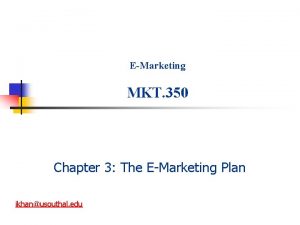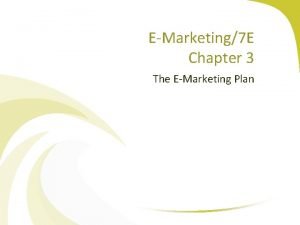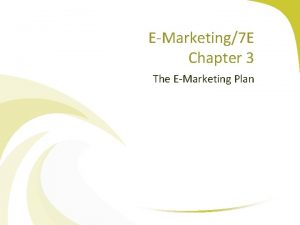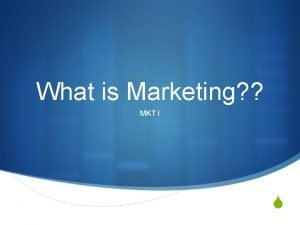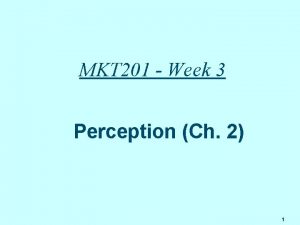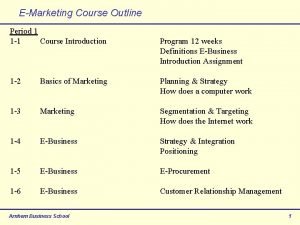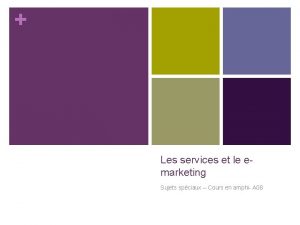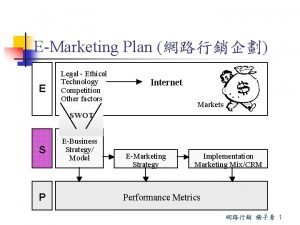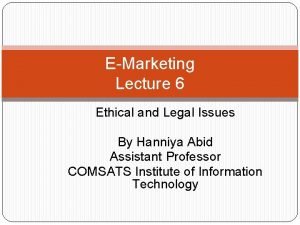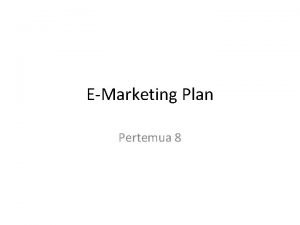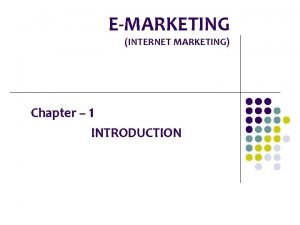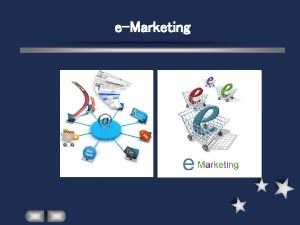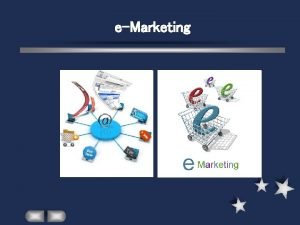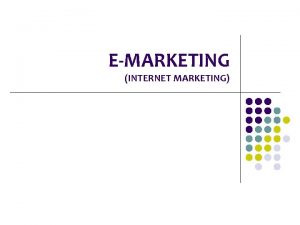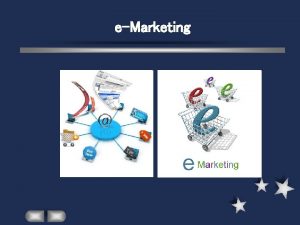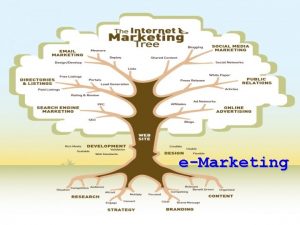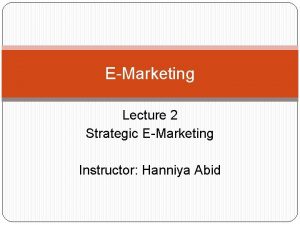EMarketing MKT 350 Chapter 3 The EMarketing Plan
























- Slides: 24

E-Marketing MKT. 350 Chapter 3: The E-Marketing Plan ikhan@usouthal. edu

Overview of the E-Marketing Planning Process Creating an E-Marketing Plan The Napkin Plan The Venture Capital E-Marketing Plan A Six-Step E-Marketing Plan Step 1—Situation Analysis Step 2—Link E-Business with E-Marketing Strategy Step 3— Formulate Objectives Step 4—Design Implementation Plan to Meet the Objectives Step 5—Budgeting Step 6—Evaluation Plan

Overview of the E-Marketing Planning Process n n The best firms have clear visions that they translate, through the marketing process, from e-business objectives and strategies into e-marketing goals and well-executed strategies and tactics for achieving those goals. This marketing process entails three steps: - Marketing plan creation, Plan implementation, Evaluation/corrective action.

The Napkin Plan n Dot-com entrepreneurs were known to simply jot their ideas on a napkin over lunch and then run off to find financing. The big company version of this is the just-do-it. An employee has an idea, and convinces management to just do it. These plans sometimes work and are sometimes even necessary but they are not recommended when substantial resources are involved. Sound planning and thoughtful implementation are needed for long-term success in business.

The Venture Capital E-Marketing Plan n Small to mid-sized firms and entrepreneurs with start-up ideas usually begin with a napkin plan without going through the entire traditional marketing planning process. BUT as the company grows and needs capital, it has to put together a comprehensive e-marketing plan. Where does an entrepreneur go for capital? - Sometimes bank loans, - Most of the time, it is equity financed, - Private funds (friends and family), - Angel investors, - Venture capitalists.

The Venture Capital E-Marketing Plan n n Investors are looking for a well-composed business plan, and more importantly, a good team to implement it. The business plan should contain enough data and logic to prove that: n The e-business idea is solid, n The entrepreneur has some idea of how to run the business.

The Venture Capital E-Marketing Plan 9 questions that every business plan should answer: n 1. 2. 3. 4. Who is the new venture’s customer? How does the customer make decisions about buying this product or service? To what degree is the product or service a compelling purchase for the customer? How will the product or service be priced?

The Venture Capital E-Marketing Plan 9 questions that every business plan should answer: n 5. 6. 7. 8. 9. How will the venture reach all the identified customer segments? How much does it cost (in time and resources) to acquire a customer? How much does it cost to produce and deliver the product or service? How much does it cost to support a customer? How easy is it to retain a customer?

The Venture Capital E-Marketing Plan n VCs look for a way to get their money and profits out of the venture within a few years: - - n The golden exit plan is to go public and issue stock in an initial public offering (IPO), As soon as the stock price rises sufficiently, the VC cashes out and moves on to another investment. All VCs’ investments are not successful. But if even one out of 20 is an Amazon. com, the risk was well worth the reward.

A Six-Step E-Marketing Plan

Step 1—Situation Analysis Planning for e-marketing does not mean starting from scratch but working with existing business, e-business, and marketing plans is an excellent place to start.

Step 1—Situation Analysis n n n The organizational e-business plan: SWOT analysis => e-business strategy. The marketing plan: gathers information about the firm’s products, the markets currently served, and so forth. The distribution plan: identifies areas where the products are currently sold and suggests geographic gaps that might be receptive to ecommerce. Promotion plan information: gives clues about how the Internet fits with the firm’s current advertising, sales promotion, and other marketing communications. The firm and brand positioning in the marketplace: Internet planners must decide how closely Web site content and promotion will follow current positioning strategies. The marketer moves to strategy formulation.

Step 2—Link E-Business with E -Marketing Strategy n Marketers need to: 1 Review the marketing and e-business plans, 2 Conduct a strategic planning to help achieve the firm’s ebusiness goals + define potential revenue streams, 3 Create supporting e-marketing strategy for the e-business goals: A Tier one strategy: marketers design segmentation, targeting, differentiation, and positioning strategies, B Tier two strategy deals with the 4 P’s and relationship management by creating strategies around the offer (product), value (pricing), distribution (place), and communication (promotion), 4 Further, marketers design customer and partner relationship strategies (CRM/PRM).


Step 3— Formulate Objectives n In general, an objective in an e-marketing plan takes the form: n Task (what is to be accomplished), n Measurable quantity (how much), n Time frame (by when).

Typical E-Marketing Objectives n Most e-marketing plans aim to accomplish multiple objectives such as: n Increase market share, n Increase sales revenue, n Reduce costs, n Achieve branding goals, n Improve databases, n Achieve customer relationship management goals, n Improve supply chain management.

Step 4 — Design Implementation Plan to Meet the Objectives n n n Select: - The marketing mix (4 Ps), - Relationship management tactics, - Other tactics to achieve the plan objectives. Devise detailed plans for implementation. Check the right marketing organization is in place for implementation.

Step 4 — Design Implementation Plan to Meet the Objectives n Information technologies are especially adept at automating these processes, this is why the information gathering tactics are important: - - Web site forms, feedback e-mail, and online surveys, Web site log analysis software helps firms review user behavior at the site and make changes to better meet the needs of users, Business intelligence uses the Internet for secondary research, assisting firms in understanding competitors and other market forces.

Step 5 — Budgeting n n A key part of any strategic plan is to identify the expected returns from an investment. Returns are matched against costs to develop a cost/benefit analysis, ROI calculation, or internal rate of return (IRR) ð n Determine whether the effort is worthwhile. During plan implementation, marketers will closely monitor actual revenues and costs ð To monitor of results are on track for accomplishing the objectives.

Revenue Forecast n n n The firm uses an established sales forecasting method for estimating the site revenues in the short, intermediate, and long term. Inputs: The firm’s historical data, industry reports, and competitive actions. An important part of forecasting is to estimate the level of Web site traffic over time. ð n This number affects the amount of revenue a firm can expect to generate from its site. Revenue streams: - Web site direct sales, Subscription fees, Sales at partner sites, fees. - Advertising sales, - Affiliate referrals, - Commissions, and other

Budgeting Intangible Benefits: Putting a financial figure on such benefits is challenging but essential for e-marketers. What is the value of increased brand awareness from a Web site? Cost Savings: Money saved through Internet efficiencies is considered soft revenue for a firm.

E-Marketing Costs n Costs for employees, hardware, software, programming, and more. n Some traditional marketing costs may creep into the e-marketing budget n The cost of a Web site can range from $5000 to $50 million. n Few of the costs site developers incur: n Technology costs: software, hardware, Internet access or hosting services, educational materials and training, and other site operation and maintenance costs. n Site design. Web sites need graphic designers to create appealing page layouts, graphics, and photos.

E-Marketing Costs n Other costs site developers incur: n n Salaries. All personnel that work on Web site development and maintenance are budget items. Other site development expenses. If not included in the technology or salary categories, any other expenses will be here (registration of multiple domain names and hiring consultants). Marketing communication. All advertising, public relations, and promotions activities, both online and offline, to draw site traffic. Search engine registration, online directory costs, e-mail list rental, prizes for contests, and more. Miscellaneous. Other typical project costs might fall here— expenses such as travel, telephone, stationery printing to add the new URL, and more.

Step 6 — Evaluation Plan n n Once the e-marketing plan is implemented, its success depends on continuous evaluation. The tracking systems should be in place before the electronic doors open. What should be measured? The plan objectives need to be evaluated with: - Balanced scorecard for e-business - ROI …
 Napkin plan in e marketing
Napkin plan in e marketing E marketing planning process
E marketing planning process Emarketing plan
Emarketing plan Plan emarketing
Plan emarketing Design mkt
Design mkt Tactical communications
Tactical communications Core product actual product
Core product actual product Lovemarks examples
Lovemarks examples 317 home work
317 home work What does mkt mean
What does mkt mean Mkt 317
Mkt 317 Mkt 201
Mkt 201 Emarketing system
Emarketing system 6 i's of e marketing
6 i's of e marketing Cours emarketing
Cours emarketing Legal emarketing
Legal emarketing Legal emarketing
Legal emarketing Hình ảnh bộ gõ cơ thể búng tay
Hình ảnh bộ gõ cơ thể búng tay Bổ thể
Bổ thể Tỉ lệ cơ thể trẻ em
Tỉ lệ cơ thể trẻ em Chó sói
Chó sói Chụp tư thế worms-breton
Chụp tư thế worms-breton Hát lên người ơi alleluia
Hát lên người ơi alleluia Môn thể thao bắt đầu bằng chữ f
Môn thể thao bắt đầu bằng chữ f
